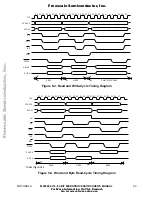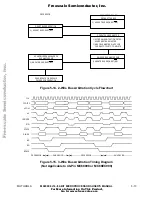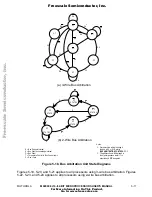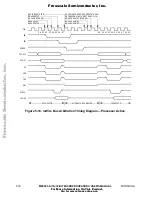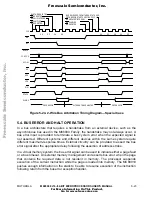
5- 16
M68000 8-/16-/32-BIT MICROPROCESSORS USER'S MANUAL
MOTOROLA
CLK
BR (EXTERNAL)
BR (iNTERNAL)
47
INTERNAL SIGNAL VALID
EXTERNAL SIGNAL SAMPLED
Figure 5-17. External Asynchronous Signal Synchronization
Bus arbitration control is implemented with a finite-state machine. State diagram (a) in
Figure 5-18 applies to all processors using 3-wire bus arbitration and state diagram (b)
applies to processors using 2-wire bus arbitration, in which
BGACK
is permanently
negated internally or externally. The same finite-state machine is used, but it is effectively
a two-state machine because
BGACK
is always negated.
In Figure 5-18, input signals R and A are the internally synchronized versions of
BR
and
BGACK
. The
BG
output is shown as G, and the internal three-state control signal is shown
as T. If T is true, the address, data, and control buses are placed in the high-impedance
state when
AS
is negated. All signals are shown in positive logic (active high), regardless
of their true active voltage level. State changes (valid outputs) occur on the next rising
edge of the clock after the internal signal is valid.
A timing diagram of the bus arbitration sequence during a processor bus cycle is shown in
Figure 5-19. The bus arbitration timing while the bus is inactive (e.g., the processor is
performing internal operations for a multiply instruction) is shown in Figure 5-20.
When a bus request is made after the MPU has begun a bus cycle and before
AS
has
been asserted (S0), the special sequence shown in Figure 5-21 applies. Instead of being
asserted on the next rising edge of clock,
BG
is delayed until the second rising edge
following its internal assertion.
F
re
e
sc
a
le
S
e
m
ic
o
n
d
u
c
to
r,
I
Freescale Semiconductor, Inc.
For More Information On This Product,
Go to: www.freescale.com
n
c
.
..


